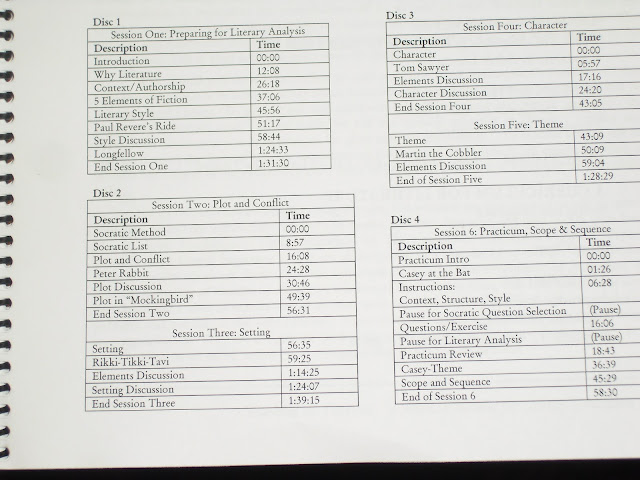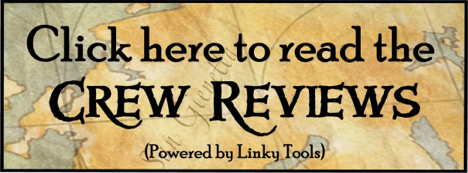Teaching the Classics contains a four-DVD set created by Adam and Missy Andrews. The course teaches parents how to teach classic literature to their children of any age. It is also suitable to
have older students watch with the parent-teacher. My child is not yet up to that task, though, so I watched the course on my own. Watch this video and hear Andrew Pudewa's description of this series:
have older students watch with the parent-teacher. My child is not yet up to that task, though, so I watched the course on my own. Watch this video and hear Andrew Pudewa's description of this series:
In Teaching the Classics, Adam Andrews walks the viewer through an education in teaching Literature. The IEW Website offers this link which shows pages from the beginning of the book, including "Getting Started with Teaching the Classics," as well as well as the "Table of Contents" and the "INTRODUCTION: Why Literature?" I am a literature lover, so the Introduction was "preaching to the choir".
Mr. Andrews weaves information with humor. After reading, he says, "Did you detect any literary devices in that poem? Did you detect any onomatopoeia in that piece? Do you know what onomatopoeia is?" and "Did you memorize that when you were a student? How many of you made your students memorize it? Shame on you for making your students do something that didn't do yourself!" He's so funny!
It was at about this point, I think, that I decided I was in love with Adam Andrews. I love a man who gets excited about literature and can convey that excitement to his students. ...Unfortunately he is married, and so am I. And I might be old enough to be his mom, I'm not sure. I'll just have to be an ardent admirer from afar, I guess. Anyway, after that moving reading he walked us through sample questions you would ask your students for any piece of literature. I was then walked through an education on the Socratic Method and "The Socratic List". And all that in Lesson 1!
Lesson 2 is entitled "PLOT and CONFLICT". Mr. Andrews introduces five general types of conflict that stories fall into: Man vs. Man, Man vs.... wait a minute... I can't give away all the good stuff...
Next we are introduced to the format of a "Story Chart" (sample below), as we listen to a rendering of The Tale of Peter Rabbit. (Did you catch that? Peter Rabbit. This program teaches you how to teach the Classics from the earliest elementary all the way to high school!)
Using the Story Chart, Mr. Andrews teaches how to break a story down, to help your student think about the characters, setting and plot, and walk the story through rising actions, climate, denoument... (wait - you don't know what that is? I can't give everything away, can I?). And there are, again, discussion questions to go through with The Story of Peter Rabbit.
There is a section of sample Story Charts for various "Great Works" (The Iliad; Macbeth; Great Expectations; and To Kill a Mockingbird).
Lesson 3 launches a teaching section about "Setting". Mr. Andrews begins this instruction with a discussion about To Kill a Mockingbird. Mr. Andrews is so enthusiastic that I am now putting this book on my "to be read" list.
Then the instructor walks the viewer through a reading of Rikki-Tikki-Tavi, by Rudyard Kipling. Again there is a story chart followed by discussion questions. The next discussion is about "Setting in Adult Literature. This section ties together summaries of the four adult works mentioned above, presented earlier with "Story Charts".
Lesson 4 focuses on "Characters". It discusses ways a writer introduces a character. This section walks the viewer through a segment of The Adventures of Tom Sawyer so enthusiastically that as soon as I finished it I immediately began searching for my copy of said book so I could read it to my son. Did I mention how enthusiastic Adam Andrews is? His enthusiasm is infectious! The segment about Tom Sawyer has its own story chart available for copying for the student, as well as discussion questions. The section concludes with a discussion about "Character in Adult Literature", discussing again the four above-mentioned pieces of adult literature.
Lesson 5 is a discussion on "Theme". Certain universal theme-types are listed, and then Mr. Andrews reads through a story, "Martin the Cobbler", and again works through the story chart and the discussion questions. This is followed by a discussion of theme in the four pieces of adult literature mentioned above.
Then in Lesson 6 Mr. Andrews read through Casey at the Bat (A Ballad of the Republic: Sung in the Year 1888), by Ernest Lawrence Thayer. (Did I mention how much I enjoy seeing a man who is enthusiastic about literature reading literature?)
Then in Lesson 6 Mr. Andrews read through Casey at the Bat (A Ballad of the Republic: Sung in the Year 1888), by Ernest Lawrence Thayer. (Did I mention how much I enjoy seeing a man who is enthusiastic about literature reading literature?)
The DVD course ends after the discussion of Casey at the Bat, but there is still more to see in the accompanying workbook. The Section called "A Curriculum for Literature" offers a Scope and Sequence for working one's students through the childrens' works covered in the above discussion (Peter Rabbit, Paul Revere's Ride, Rikki-Tikki-Tavi, Tom Sawyer, Martin the Cobbler) as well as Huckleberry Finn, by Mark Twain.
There are additional suggestions and resources, suggestions for Daily Lesson Plans, writing assignments, and additional Appendices. Appendix A covers questions to use when leading Socratic discussions. Appendix B contains Reading Lists for various age levels. And Appendix C defines Important Literary Terms.
Adam Andrews is so funny! I love this DVD series!
Teaching the Classics is available from Institute for Excellence in Writing for $89.00. I am very thankful to have had the opportunity to review this product. Not only did I need the training now, but I especially needed to be prepared for high school with my son, which is only a year away. I watched through this DVD series once so far, but I intend to watch it again before school starts, and I will probably watch it again before 9th grade gets here! I was instructed in the "Socratic Method" of leading discussions in the past, but it's been about ten years since then, and I truly needed the re-education. Teaching Socratically does not seem to come easily for me, so I will definitely be continuing to apply myself to this series to prepare myself for these future discussions.
I recommend you watch the "preview" videos I have provided and get a flavor of Mr. Andrews' lecture skills. You will see what I mean.
If you wish to read more Crew Reviews of this product, or see the other IEW products that were reviewed, please click the link below.
I recommend you watch the "preview" videos I have provided and get a flavor of Mr. Andrews' lecture skills. You will see what I mean.
If you wish to read more Crew Reviews of this product, or see the other IEW products that were reviewed, please click the link below.








No comments :
Post a Comment